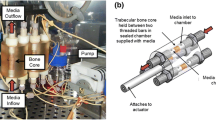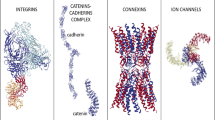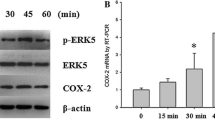Abstract
The shear stress induced by the loading-mediated flow of interstitial fluid through the lacuno–canalicular network is a likely stimulus for bone cell adaptive responses. Furthermore, the magnitude of the cellular response is related to the rate of mechanical loading rather than its magnitude. Thus, bone cells might be very sensitive to sudden stress-kicks, as occuring e.g., during impact loading. There is evidence that cells change stiffness under stress, which might make them more sensitive to subsequent loading. We studied the influence of a stress-kick on the mechanosensitivity of MC3T3-E1 osteoblast-like cells under different peak shear rate conditions, as measured by nitric oxide production. MC3T3-E1 bone cells were treated with steady or pulsating fluid shear stress (PFSS) for 5 min with different peak rates (9.70, 17.5, and 22.0 Pa Hz) using varying frequencies (5 and 9 Hz), and amplitudes (0.70 and 0.31 Pa). PFSS treatment was done with or without fluid flow pretreatment phase, which removed the initial stress-kick by first applying a slow fluid flow increase. Nitric oxide production in response to fluid shear stress was rate dependent, but necessitated an initial stress-kick to occur. This suggests that high-rate stimuli condition bone cells to be more sensitive for high-frequency, low-amplitude loads.
Similar content being viewed by others
References
Ajubi, N. E., J. Klein-Nulend, P. J. Nijweide, T. Vrijheid-Lammers, M. J. Alblas, and E. H. Burger. Pulsating fluid flow increases prostaglandin production by cultured chicken osteocytes—a cytoskeleton-dependent process. Biochem. Biophys. Res. Comm. 225:62–68, 1996.
Bacabac, R. G., T. H. Smit, S. C. Cowin, J. J. W. A. Van Loon, F. T. M. Nieuwstadt, R. M. Heethaar, and J. Klein-Nulend. Dynamic shear stress in parallel-plate flow chambers. J. Biomech. in press.
Bacabac, R. G., T. H. Smit, R. M. Heethaar, J. J. W. A.Van Loon, M. J. M. B. Pourquie, F. T. M. Nieuwstadt, and J. Klein-Nulend. Characteristics of the parallel-plate flow chamber for mechanical stimulation of bone cells under microgravity. J. Gravitat. Physiol. 9:P181–P182, 2004.
Bacabac, R. G., T. H. Smit, M. G. Mullender, S. J. Dijcks, J. J. W. A. Van Loon, and J. Klein-Nulend. Nitric oxide production by bone cells is fluid shear stress rate dependent. Biochem. Biophys. Res. Commun. 315:823–829, 2004.
Bakker, A. D., K. Soejima, J. Klein-Nulend, and E. H. Burger. The production of nitric oxide and prostaglandin E2 by primary bone cells is shear stress dependent. J. Biomech. 34:671–677, 2001.
Burger, E. H., and J. Klein-Nulend. Mechanotransduction in bone-Role of the lacuno-canalicular network. FASEB J. 13:S101–S112, 1999.
Chen, N. X., K. D. Ryder, F. M. Pavalko, C. H. Turner, D. B. Burr, J. Qiu, and R. L. Duncan. Ca2+ regulates fluid shear-induced cytoskeletal reorganization and gene expression in osteoblasts. Am. J. Physiol. Cell Physiol. 278:C989–C997, 2000.
Cowin, S. C. Bone poroelasticity. J. Biomech. 32:217–238, 1999.
Forwood, M. R. Inducible cyclo-oxygenase (COX-2) mediates the induction of bone formation by mechanical loading In vivo. J. Bone Miner. Res. 11:1688–1693, 1996.
Fox, S. W., T. J. Chambers, and J. W. M. Chow. Nitric oxide is an early mediator of the induction of bone formation by mechanical stimulation. Bone 19:687–687, 1996.
Frangos, J. A., and D. Johnson. Fluid flow in bone: Stimulated release at remodeling mediators. Biorheology 32:187–187, 1995.
Fritton, S. P., J. McLeod, and C. T. Rubin. Quantifying the strain history of bone: Spatial uniformity and self-similarity of low-magnitude strains. J. Biomech. 33:317–325, 2000.
Gammaitoni, L. Stochastic resonance. Rev. Mod. Phys. 70:223–287, 1998.
Hung, T., F. D. Allen, S. R. Pollack, and C. T. Brighton. What is the role of the convective current density in the real-time calcium response of cultured bone cells to fluid flow? J. Biomech. 29:1403–1409, 1996.
Jacobs, C. R., C. E. Yellowley, B. R. Davis, Z. Zhou, and H. J. Donahue. Differential effect of steady versus oscillating flow on bone cells. J. Biomech. 31:55–55, 1998.
Johnson, D. L., T. N. McAllister, and J. A. Frangos. Fluid flow stimulates rapid and continuous release of nitric oxide in osteoblasts. Am. J. Physiol. 271:E205–E208, 1996.
Judex, S., and R. F. Zernicke. High-impact exercise and growing bone: Relation between high strain rates and enhanced bone formation. J. App. Physiol. 88:2183–2191, 2000.
Klein-Nulend, J., J. Roelofsen, J. G. Sterck, C. M. Semeins, and E. H. Burger. Mechanical loading stimulates the release of transforming growth factor-beta activity by cultured mouse calvariae and periosteal cells. J. Cell Physiol. 163:115–119, 1995.
Klein-Nulend, J., P. A. van der, C. M. Semeins, N. E. Ajubi, J. A. Frangos, P. J. Nijweide, and E. H. Burger. Sensitivity of osteocytes to biomechanical stress in vitro. FASEB J. 9:441–445, 1995.
Klein-Nulend, J., C. M. Semeins, N. E. Ajubi, P. J. Nijweide, and E. H. Burger. Pulsating fluid flow increases nitric oxide (NO) synthesis by osteocytes but not periosteal fibroblasts-Correlation with prostaglandin upregulation. Biochem. Biophys. Res. Comm. 217:640–648, 1995.
Knothe Tate, M. L., P. Niederer, and U. Knothe. In vivo tracer transport through the lacuno-canalicular system of rat bone in an environment devoid of mechanical loading. Bone 22:107–117, 1998.
Knothe Tate, M. L., and U. Knothe. An ex vivo model to study transport processes and fluid flow in loaded bone. J. Biomech. 33:247–254, 2000.
Kodama, H. A., Y. Amagai, H. Sudo, and S. Kasai, S. Yamamoto. Establishment of a clonal osteogenic cell line from newborn mouse calvaria. J. Oral Biol. 23:899–901, 1981.
Kondepudi, D. K. Detection of gravity through nonequilibrium mechanisms. ASGB Bulletin 4:119–124, 1991.
Mosley, J. R., and L. E. Lanyon. Strain rate as a controlling influence on adaptive modeling in response to dynamic loading of the ulna in growing male rats. Bone 23:313–318, 1998.
Mullender, M., A. J. El Haj, Y. Yang, J. Magnay, M. A. van Duin, and J. Klein-Nulend. Fluid flow and mechanical strain induce different responses in human bone cells. Transactions of the 49th Annual Meeting of the Orthopaedic Research Society 28:(abstract), 2003.
Nordstrom, P., U. Pettersson, and R. Lorentzon. Type of physical activity, muscle strength, and pubertal stage as determinants of bone mineral density and bone area in adolescent boys. J. Bone Miner. Res. 13:1141–1148, 1998.
Owan, I., D. B. Burr, C. H. Turner, J. Qiu, Y. Tu, J. E. Onyia, and R. L. Duncan. Mechanotransduction in bone: Osteoblasts are more responsive to fluid forces than mechanical strain. Am. J. Physiol. 273:C810–C815, 1997.
Pavalko, F. M., N. X. Chen, C. H. Turner, D. B. Burr, S. Atkinson, Y. F. Hsieh, J. Qiu, and R. L. Duncan. Fluid shear-induced mechanical signaling in MC3T3-E1 osteoblasts requires cytoskeleton-integrin interactions. Am. J. Physiol. 275:C1591–C1601, 1998.
Piekarski, K., and M. Munro. Transport mechanism operating between blood supply and osteocytes in long bones. Nature 269:80–82, 1977.
Pierson, D., and F. Moss. Detecting periodic unstable points in noisy chaotic and limit cycle attractors with applications to biology. PRL 75:2124–2127, 1995.
Rubin, C. T., and L. E. Lanyon. Regulation of bone formation by applied dynamic loads. J. Bone Joint Surg. Am. 66:397–402, 1984.
Rubin, C. T., D. W. Sommerfeldt, S. Judex, and Y. X. Qin. Inhibition of osteopenia by low magnitude, high-frequency mechanical stimuli. Drug Discov. Tod. 6:848–858, 2001.
Smalt, R., F. T. Mitchell, R. L. Howard, and T. J. Chambers. Induction of NO and prostaglandin E2 in osteoblasts by wall-shear stress but not mechanical strain. Am. J. Physiol. 273:E751–E758, 1997.
Smit, T. H., E. H. Burger, and J. M. Huyghe. A case for strain-induced fluid flow as a regulator of BMU-coupling and osteonal alignment. J. Bone Miner. Res. 11:2021–2029, 2002.
Tanaka, M., S. Ejiri, M. Nakajima, S. Kohno, and H. Ozawa. Changes of cancellous bone mass in rat mandibular condyle following ovariectomy. Bone 25:339–347, 1999.
Tanaka, S. M., I. Alam, and C. H. Turner. Stochastic resonance in osteogenic response to mechanical loading. FASEB J. 02–0561fje, 2002.
Turner, C. H., I. Owan, and Y. Takano. Mechanotransduction in bone: Role of strain rate. Am. J. Physiol. 269:E438–E442, 1995.
Turner, C. H., Y. Takano, I. Owan, and G. A. Murrell. Nitric oxide inhibitor L-NAME suppresses mechanically induced bone formation in rats. Am. J. Physiol. 270:E634–E639, 1996.
Wang, N., J. P. Butler, and D. E. Ingber. Mechanotransduction across the cell surface and through the cytoskeleton. Science 260:1124–1127, 1993.
Weinbaum, S., S. C. Cowin, and Y. Zeng. A model for the excitation of osteocytes by mechanical loading-induced bone fluid shear stresses. J. Biomech. 27:339–360, 1994.
Williams, J. L., J. P. Iannotti, A. Ham, J. Bleuit, and J. H. Chen. Effects of fluid shear stress on bone cells. Biorheology 31:163–170, 1994.
Author information
Authors and Affiliations
Corresponding author
Rights and permissions
About this article
Cite this article
Bacabac, R.G., Smit, T.H., Mullender, M.G. et al. Initial Stress-Kick Is Required for Fluid Shear Stress-Induced Rate Dependent Activation of Bone Cells. Ann Biomed Eng 33, 104–110 (2005). https://doi.org/10.1007/s10439-005-8968-5
Issue Date:
DOI: https://doi.org/10.1007/s10439-005-8968-5




